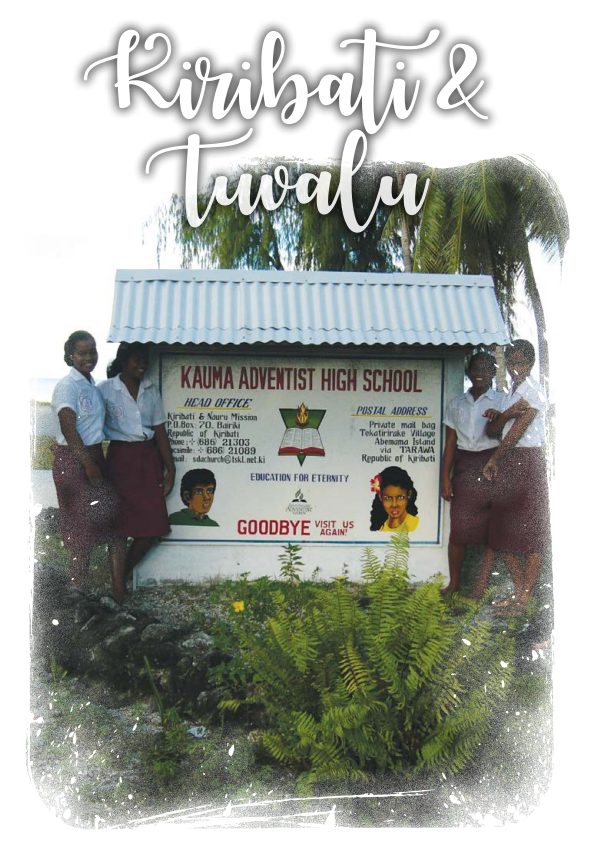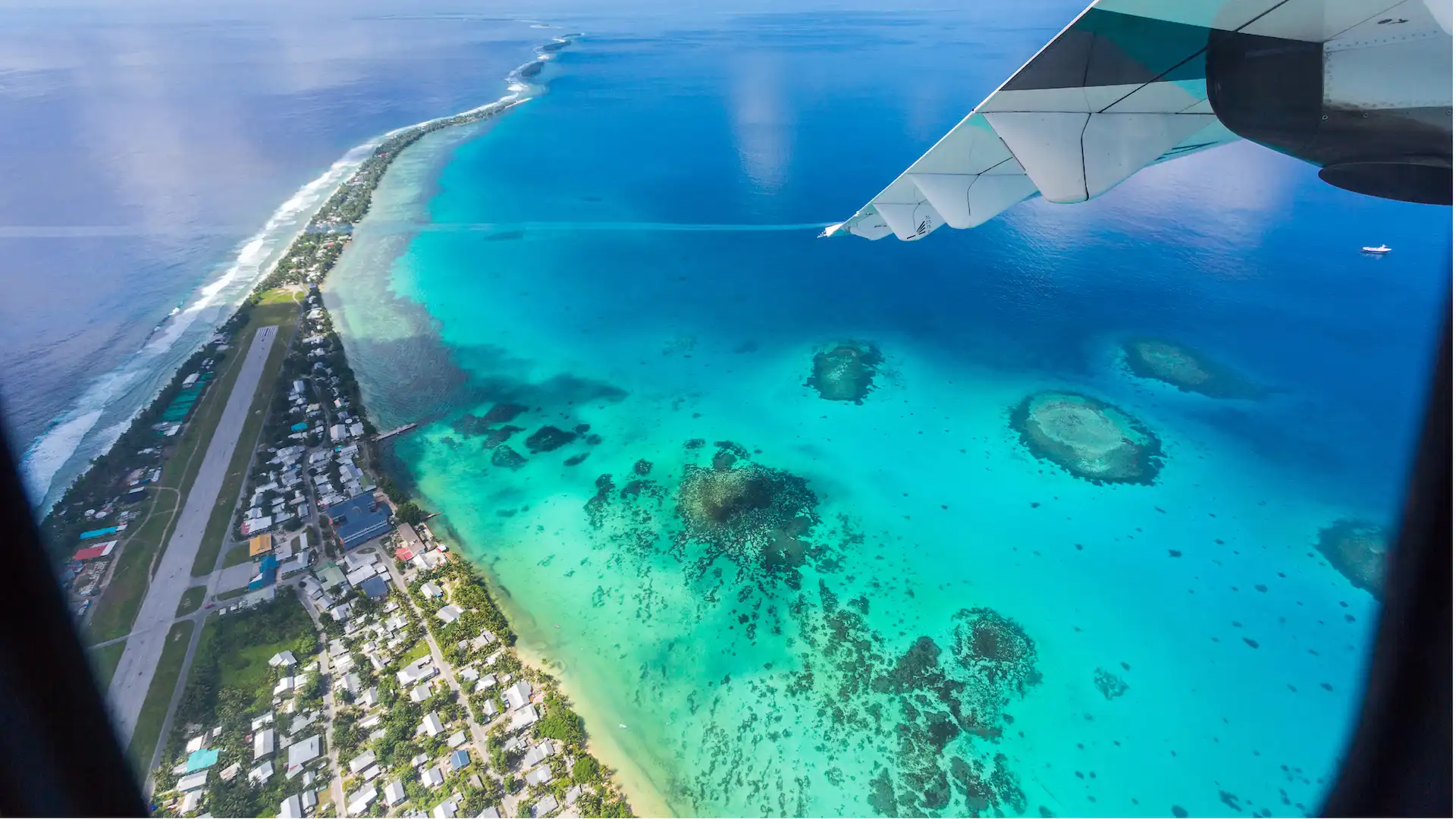Kiribati & Tuvalu

Tobinabina
During the Japanese occupation of the Kiribati (Gilbert) island of Abemama, a local magistrate began to live a double life. He juggled his responsibilities to King George VI of the displaced British administration with superficial display of cooperation with the Japanese invaders.
During the day, Tobinabina was a translator for the Japanese; at night, he moved from home to home, recording births, marriages, deaths and collecting taxes for the British Government to honour a promise he had made to the Crown via Tem Binoka, the former King of Abemama. One night, his duplicity was discovered by Japanese soldiers, who confronted him. “The fish are biting,” he told them, so they would think he was fishing. The expression was in fact a password he used in collecting his information. He was taken to a guard house and questioned, but his secret remained hidden.
At the war’s end, the British returned. Tobinabina dressed in his clean lava-lava, put on a white shirt and his belt of office indicating his official capacity as Chief Magistrate of Abemama, then handed over the correctly collected taxes and the orderly presented books. For his heroic effort, Tobinabina was awarded the Medal of the British Empire by the King via the High Commissioner for the South Pacific.
In 1947, Tobinabina became a member of the Seventh-day Adventist church, working for the church. Tobinabina was a positive influence. He maintained calmness and patience during time of stress, and the missionaries relied on his wisdom. His family continued his legacy, with his son appointed the Government Officer. His children attended the Kauma SDA High School, the only secondary school on the island.
Reference:
Miller, Z. (2004). A remarkable character in war and peace: Tobinabina of Kiribati, 1943-1945, 1951-1952. Journal of Pacific Adventist History. 4(1), pp. 4-8.
Te Bao
Te Bao and his wife Arataki were baptised in January 1949. Te Boa later would become the first indigenous Adventist minister in Kiribati.
Biribo Kabaneiti
Biribo Kabaneiti was born on Tarawa in the Republic of Kiribati in May 1967. He gained an education at Kauma Adventist High School and then at Betikama Adventist High school in the Solomon Islands. In 1990, he married Kirita. They attended Pacific Adventist University [College?] from 1991–1994, where he gained his bachelor’s degree in Theology.
On returning home, he served as the pastor of Kauma Adventist High School. Then in 1994, he was appointed a departmental director at the mission headquarters at Korobu on Tarawa. Here he assisted Dr Harley Stanton, the associate Health Department director of the South Pacific Division, in conducting seminars for government and community leaders on tobacco-control in Kiribati. He was ordained in August 1999 then unexpectedly died just five days later.
A quietly spoken, courteous, efficient and spiritually mature worker, he possessed the qualities of stability and leadership, enriching the church he loved and served.
Reference:
Life Sketches: Biribo Kabanetit: 1967-1999. Journal of Pacific Adventist History. 2(1), p. 39.
First church in Australia
On May 10, 1885, 11 Americans set sail on the Australia from San Francisco, USA, with plans to establish the Seventh-day Adventist Church in Australia. The pioneer workers included Pastor Stephen Haskell; Pastor Mendel Israel, accompanied by his wife and two daughters; Pastor John Corliss, accompanied by his wife and two children; Henry Scott, a printer from Pacific Press; and William Arnold, a colporteur.
They arrived in Sydney on June 6, 1885. While Pastors Haskell and Israel stayed in Sydney, the others continued aboard a coastal steamer to Melbourne, which had been selected to be the base for the Church’s Australian activities as there were rumours of Sabbath-keepers living there. They formed the first Seventh-day Adventist church in Australia in Melbourne on January 10, 1886, with 29 members.
First church in New Zealand
Pastor Haskell, who was keen to spread the message in New Zealand where the pioneers had called on their initial voyage to Australia, returned to Auckland and began distributing the Church’s outreach publication The Bible Echo and Signs of the Times. Reports of Haskell’s successes in New Zealand caused the leaders of the Church in America to delegate A.G. Daniels, an evangelist, to travel to New Zealand to develop the work further. Daniels, an enthusiastic preacher, had great success and in 1887 opened the first Seventh-day Adventist church in New Zealand at Ponsonby. Daniels would eventually go on to become the world president of the Seventh-day Adventist Church.
First Adventist contact in the Pacific Islands
In 1886, John I Tay, an American layman, reached Pitcairn Island aboard a vessel of the Royal Navy. He stayed on the island until another ship arrived. Tay’s simple teaching fascinated the islanders as the message matched with the message of literature—Signs of the Times—sent years previously from America by James White and John Loughborough. Within weeks, the islanders accepted the suite of Adventist truths. When Tay left, he promised to send someone to baptise the group.
Upon his return to America, Tay’s accounts inspired other Adventists to visit Pitcairn. One, Pastor Andrew J Cudney, found an old schooner, the Phoebe Chapman, and he and a crew sailed for Tahiti where they planned to pick up John Tay before sailing to Pitcairn Island. Sadly, they never arrived, as the ship was lost at sea.
Tay was anxious to return to Pitcairn Island and a boat was required. Funds from Sabbath Schools across America raised money for one, the aptly named Pitcairn, which under Captain Joseph Melville Marsh, was ready to sail in October 1880. Tay was joined by two other enthusiastic missionary couples, Edward Gates and the Albert J. Read, who were greeted enthusiastically by the islanders on Pitcairn. Eightysix people were baptised and a church formally organised.
When the Pitcairn departed the island three weeks later, on board were three Pitcairn islanders who wished to spread the Adventist faith. As the ship travelled westward from island to island, literature was distributed, evangelical meetings held, and medical treatments dispensed. After visiting Papeete, the Cook Islands, Samoa, Tonga, Fiji and Norfolk Island, it arrived in Auckland, New Zealand. There they
heard the news of Tay’s death in Fiji. The Pitcairn returned to California, carrying missionaries on five more Pacific voyages.
Early Australian and New Zealand Missionaries to the Pacific
As a result of the four voyages from America into the Polynesia, missions were established in Pitcairn, Tahiti, Cook Islands, Samoa, Tonga and Fiji. Most of the next wave of missionaries had their origins in Australia and New Zealanders.
Due to the fact Pitcairn never visited the Gilbert/Kiribati or Tuvalu Islands, other American missionaries entered the Kiribati Islands.
The roots of the Adventist mission began in Samoa. During the 1930s, handful of Tuvalu islanders attended the Vailoa Training School and the plan was that these men would spearhead the Adventist mission in their home islands, but due to the war, plans changed.
It was not until after World War 2 that the Gilbert and Ellis Islands were entered by Seventh-day Adventists. John Howse, son of Timothy Howse, a missionary to Samoa, was chosen to take Adventism to the island groups. Howse was one of the missionaries evacuated from the Solomon Islands when the Japanese moved south.
From 1947, Howse pioneered the work in this chain of islands. With a new boat, named Fetu Ao, he explored the islands, often in the company of a government official, as the Tuvaluans had forbidden the intrusion of further Christian groups. Howse used every possible means to advertise his presence, also by ferrying government and religious officials without charge.
The work of the church expanded gradually under Howse’ leadership, with the first baptism in 1949. A second, two months later, included seven former London Missionary Society members, relatives of Niu. One of these candidates, Kusi, son of Luteru and Leitu, became the first Tuvaluan to be ordained. A third baptism in 1950, included Binabina, who was later ordained and translated the Voice of Prophecy Bible
lessons, and his wife Tekaua. As an ex-government translator, he had permission to preach on all the islands of Kiribati.
The Adventist mission work in the Tuvalu Islands was more difficult. In 1951, the Howse family was followed by a series of missionaries. Only in 1954 was the first church formed to complement the School at Kauma on Abemama, on land provided by Binabina, a candidate in the third baptism. The membership has continued to rise over the years thanks to the efforts of the local workers.
As a result of the four voyages from America into the Polynesia, missions were established in Pitcairn, Tahiti, Cook Islands, Samoa, Tonga and Fiji. Most of the next wave of missionaries had their origins in Australia and New Zealanders.
Due to the fact Pitcairn never visited the Gilbert/Kiribati or Tuvalu Islands, other American missionaries entered the Kiribati Islands.
The roots of the Adventist mission began in Samoa. During the 1930s, handful of Tuvalu islanders attended the Vailoa Training School and the plan was that these men would spearhead the Adventist mission in their home islands, but due to the war, plans changed.
In 1944, when hostilities had abated, Samuelu and Sieni left Samoa and returned to Tuvalu to begin their mission work. Another Tuvaluan young man, Tavita Niu, a former student of Vailoa, was sent as a paid missionary from Samoa. Tavita’s father, Niu, a Tuvaluan owned land on the islands of Nukulailai, Funafuti and Nukufetau. It was suggested that Tavita return to his father’s place as trustee of the land. By 1946, this family begun a little Sabbath School on Funafuti Island.
Timeline of the SDA church in Kiribati and Tuvalu
| 1930s | Handful of Tuvalu islanders attended the Vailoa Training School with the idea they would spearhead the Adventist mission in their home islands, but due to the war, plans changed | |
| 1944 | War-related hostilities abate and Samuelu and Sieni leave Samoa and return to Tuvalu to begin their mission work | |
| 1947 | Tavita Niu, a Tuvaluan former student of Vailoa, takes his father’s place as trustee of his father’s land on Nukulailai, Funafuti and Nukufetau John Howse explored the chain of islands in a new boat, named Fetu Ao, often in the company of a government official as the Tuvaluans had forbidden the intrusion of further Christian groups First baptism; second baptism two months later included seven London Missionary Society members, many relatives of Tavita Niu | |
| 1950 | Third baptism, which included Binabina & wife Tekaua, who later translated Voice of Prophecy lessons and ordained | |
| 1951 | Pioneer Howse family was replaced by a series of missionaries | |
| 1954 | First church formed to complement the school at Kauma, Abemama, on land provided by Binabina Membership continues to rise due to efforts of the local workers |
References:
Hook, M. The Late Expansion: Early Adventism in Kiribati and Tuvulu. Booklet 32: Seventh-day Adventist Heritage Series. Wahroonga, NSW: South Pacific Division Department of Education.
Miller, Z. (2004). A remarkable character in war and peace: Tobinabina of Kiribati, 1943-1945, 1951-1952. Journal of Pacific Adventist History. 4(1), pp. 4-8.

